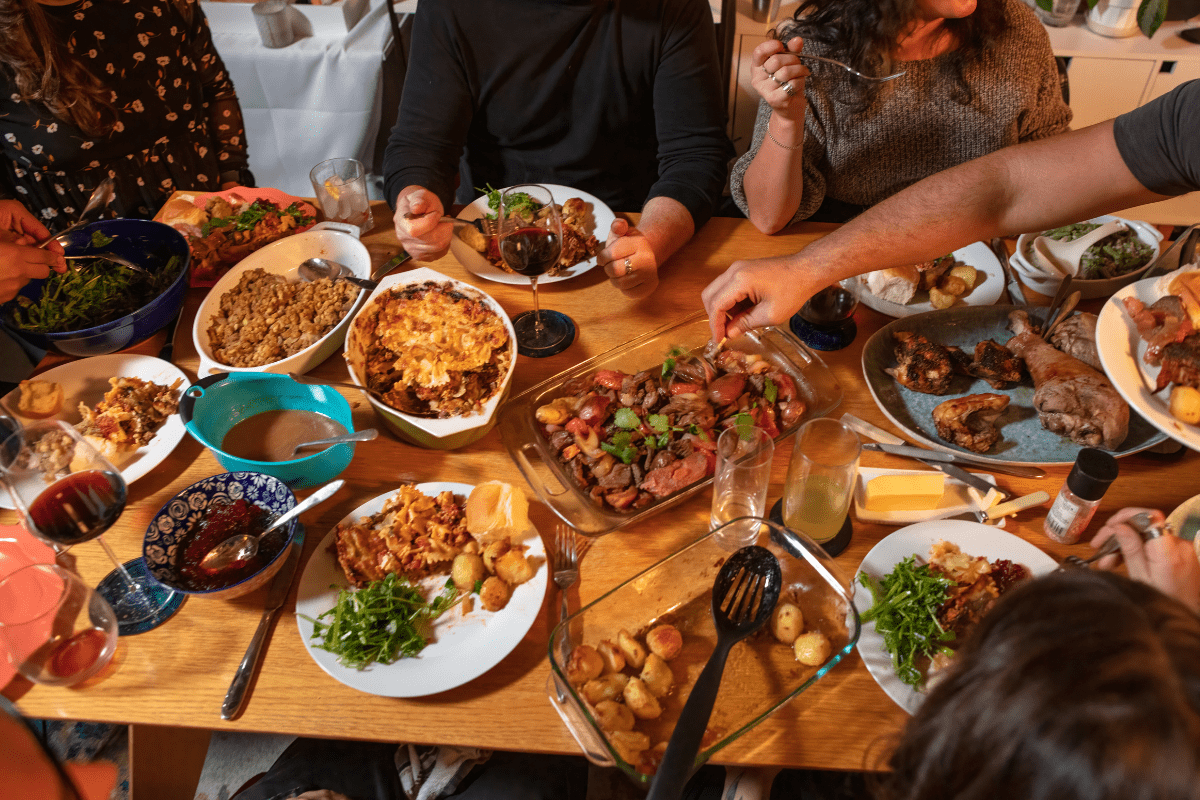Illinois cuisine reads like a delicious history book written by immigrants, perfected by necessity, and bound together with melted cheese. From towering deep dish pizzas that make New Yorkers apoplectic to Italian beef sandwiches that require both hands and a stack of napkins, the Land of Lincoln has transformed humble ingredients into culinary icons.
This is the story of how a crossroads state created food so memorable that tourists plan entire vacations around eating it.
The heavyweight champion: Deep dish pizza
Let's address the elephant in the room, or rather, the three-inch-tall pizza that looks like it could double as a boat anchor.
The real origin story (spoiler: not who you think)
Forget what you've heard about Ike Sewell inventing deep dish pizza. The true father of this controversial creation was Ric Riccardo, born Richard Novaretti, who first served this gravity-defying pie at 29 E. Ohio Street on December 3, 1943. When Riccardo discovered cast iron pans and pizza ovens at his new location, he decided to experiment with something that would make his Italian ancestors either proud or deeply confused.
But the real magic happened in the 1960s when Alice Mae Redmond, a Black cook from Mississippi, brought her Southern sensibilities to the kitchen. She incorporated techniques from her biscuit recipe, adding oil, cream of tartar, and sugar to create that stretchy, buttery crust that makes deep dish legendary. It's a perfect example of how Chicago's best foods often come from unexpected cultural collaborations.
What makes it different (besides everything)
Deep dish pizza breaks every rule of traditional pizza making, and that's exactly the point. Here's what sets it apart:
- Inverted construction methodology
- Cheese placed directly on crust
- Toppings layered above cheese
- Chunky tomato sauce crowning everything
- 35-45 minute baking time
- Fork and knife required equipment
- Structural integrity of small building
This architectural marvel led Jon Stewart to famously denounce it as "a casserole" in 2013. Chicago responded by continuing to eat it anyway, because who takes pizza advice from a guy who thinks folding a slice in half counts as innovation?
Where to worship at the altar of cheese
Each deep dish temple has its own doctrine. Lou Malnati's, founded in 1971, trademarked their "Buttercrust" and has been using the same Wisconsin dairy for over 40 years, proving that loyalty in Chicago extends beyond sports teams. Giordano's went even further in 1974, creating stuffed pizza by adding a second crust layer, because apparently one crust wasn't enough carbs.
Then there's Pequod's, which pioneered the caramelized cheese crust by letting cheese overflow between the dough and pan edges. It's the pizza equivalent of finding money in your couch cushions, except it's crispy cheese and you put it there on purpose.
The dirty little secret locals know
Here's something the tourism board won't tell you: according to Grubhub data, Chicago locals actually prefer thin-crust pizza 91% to 9% over deep dish. That's right, deep dish is basically the Navy Pier of pizza. Locals know it exists, they'll take visiting relatives there, but on a random Tuesday night? They're ordering tavern-style thin crust cut into squares like civilized Midwesterners.
Italian beef: The sandwich that built Chicago
If deep dish pizza is Chicago's showboat, Italian beef is its hardworking backbone.
Born from "peanut weddings" and immigrant ingenuity
The Italian beef sandwich emerged from Chicago's Italian-American community during the 1920s and 1930s, specifically from "peanut weddings." These budget celebrations got their name because hosts could only afford to serve peanuts and other cheap snacks. To feed large crowds with minimal meat, families would slow-braise tough beef cuts in spicy broth and slice them paper-thin.
Anthony Ferreri, a post-WWI street vendor, realized a deli slicer could create even thinner slices, stretching the meat further. His son Al took this innovation and opened Al's #1 Italian Beef in 1938, turning frugality into an art form that would eventually claim over 150 culinary awards.
The anatomy of perfection
Creating authentic Italian beef requires more precision than a Swiss watch:
- Inside round or top sirloin
- Slow-roasted in seasoned stock
- Sliced impossibly thin
- Soaked in cooking juices
- Served on Italian bread
- Sweet peppers or hot giardiniera
- Structural engineering degree helpful
Ordering requires its own vocabulary. "Wet" means the bread gets a quick dip in the juice. "Dipped" means the entire sandwich takes a bath, creating something that's part sandwich, part soup, entirely delicious. Choose wrong and you'll either have dry bread or need to eat your sandwich with a spoon. There is no in-between.
Where legends are made, one sandwich at a time
Beyond Al's, the Italian beef landscape includes Johnnie's Beef in Elmwood Park, which maintains cash-only traditions and lines that stretch out the door regardless of weather. Portillo's, which started as a hot dog stand in 1963, has spread Italian beef gospel to over 50 locations nationwide. And Mr. Beef on Orleans Street gained new fame as the exterior location for "The Bear" TV series, proving that even fictional chefs know where to find the real deal.
Each establishment guards their spice blends and gravy recipes like state secrets. Some add oregano, others swear by basil, and a few rebels even add a touch of mint. The only thing they agree on is that ketchup has no place anywhere near an Italian beef, a policy that extends to most Chicago foods.
Chicago-style hot dogs: Don't even think about the ketchup
Speaking of ketchup hatred, let's talk about the Chicago-style hot dog, where condiment choices can end friendships.
From World's Fair innovation to Depression-era feast
The story begins at the 1893 World's Columbian Exposition when Austrian-Hungarian immigrants Emil Reichel and Samuel Ladany founded Vienna Beef. But the fully loaded version we know today emerged during the Great Depression when vendors advertised hot dogs with "a salad on top" for just five cents. It was marketing genius, turning necessity into desirability.
The seven sacred toppings read like a multicultural peace treaty:
- Yellow mustard (German influence)
- Chopped white onions (universal)
- Bright green relish (artificially colored)
- Dill pickle spear (Eastern European)
- Tomato wedges (Italian gardens)
- Sport peppers (mysterious origins)
- Celery salt (Chicago specific)
Each element reflects Chicago's immigrant heritage, assembled on a poppy seed bun that a Polish immigrant named Sam Rosen created in 1909. It's basically the United Nations of hot dogs, assuming the UN banned ketchup.
The great ketchup prohibition
The no-ketchup rule isn't just preference, it's cultural identity. Barack Obama once declared ketchup acceptable only for children under eight years old. The National Hot Dog & Sausage Council officially agrees. Jimmy Faruggia of Jimmy's Red Hots believed ketchup was historically used to mask spoiled meat, while purists argue the seven toppings create a perfect balance that ketchup would destroy.
Vienna Beef has built an empire on this philosophy, generating $130 million annually while spreading the gospel of proper hot dog construction. Legendary spots like Superdawg (which substitutes pickled tomatoes), The Wieners Circle (known for char-dogs and colorful customer service), and Jimmy's Red Hots (open since 1954) all maintain the ketchup ban with religious fervor.
Garrett Popcorn and the sweet-salty revelation
Sometimes the best innovations come from rule-breakers, which brings us to Garrett Popcorn and the Chicago Mix.
When customers know best
In 1949, Gladys Otto opened the first Garrett Popcorn shop at 10 West Madison Street, selling CaramelCrisp and CheeseCorn for five cents per bag. The revolutionary Chicago Mix wasn't actually Garrett's idea. In the 1970s, customers started buying both flavors separately along with an empty bag to mix them together. Garrett finally made it official in 1977, proving that sometimes the customer really does know best.
The sweet-and-salty combination seems obvious now, but at the time it was revolutionary. Like peanut butter and jelly or movies and popcorn, some things just belong together, even if it takes a while to figure that out.
The trademark battle nobody won
In 1992, Minnesota's Candyland Inc. claimed rights to the name "Chicago Mix," forcing Garrett to rename their signature blend "Garrett Mix." It's like trying to trademark "New York attitude" or "Los Angeles traffic." Some things belong to a city, not a corporation.
Despite the name change, the mix became a Chicago icon. It earned a spot on Oprah's Favorite Things in 2002 and regularly causes 45-minute lines in subzero temperatures at the Michigan Avenue location. Tourists leave with bags that cost more than their lunch, and somehow it feels worth it.
Beyond Chicago: Regional treasures worth the drive
Illinois extends far beyond the Chicago city limits, and so does its culinary creativity.
Southern Illinois sweet treats and BBQ supremacy
Down south, they're doing their own thing with vibrant pink cookies that look like they were decorated by unicorns. These super-sweet confections with pink icing can be found at places like Davis Pastry in Anna, where subtlety went to die and everyone's happier for it.
Murphysboro earned the title "BBQ Capital of Illinois" from the Illinois House in 2015, with establishments like 17th Street Barbecue proving that Chicago doesn't have a monopoly on meat mastery. Their apple pie dessert weighs three pounds. That's not a typo. Three. Pounds.
Central Illinois: Where horseshoes aren't just for horses
Springfield gave us more than just Lincoln sites. In 1928, Chef Joe Schweska at the Old Leland Hotel invented the horseshoe sandwich. This open-faced monstrosity features:
- Texas toast as foundation
- Hamburger patty or ham
- Mountain of French fries
- Cheese sauce tsunami
- Structural integrity optional
- Cardiologist on speed dial
The Cozy Dog, a corn dog precursor, also debuted at the Illinois State Fair in the 1940s. It's basically a hot dog on a stick wrapped in cornmeal batter, proving that Illinoisans will find a way to add carbs to anything.
Quad Cities pizza breaks all the rules (different ones)
The Quad Cities developed their own pizza style that makes Chicago deep dish look conventional:
- Malt added to crust
- Spicy sauce with chili flakes
- Toppings placed under cheese
- Cut into strips, not triangles
- Fennel sausage hand-ground daily
- Geography lessons included free
Happy Joe's even invented taco pizza here, topping pies with refried beans, spiced meat, and post-baking additions of lettuce, tomatoes, and Doritos. It shouldn't work, but it does, proving that pizza innovation didn't stop with deep dish.
Hidden gems and multicultural marvels
Chicago's lesser-known specialties showcase how immigration continues to shape the city's palate.
When plantains replace bread
In 1996, Juan "Pete" Figueroa created the jibarito at Borinquen Restaurant, replacing bread with twice-fried plantains. This Puerto Rican-Chicago fusion represents the city's Latino community perfectly: taking traditional elements and creating something entirely new that makes you wonder why nobody thought of it sooner.
The sandwich that requires a bib and a nap
Bridgeport's breaded steak sandwich from Ricobene's features pounded, breaded, and fried skirt steak topped with marinara and mozzarella. It's like chicken parmesan's beefier, messier cousin who shows up to family gatherings on a motorcycle. One sandwich could feed a small family or one very hungry Chicagoan.
Opa! The cheese is on fire!
Flaming saganaki arrived in Greektown in 1968 when someone decided regular cheese wasn't dramatic enough. The dish involves dousing Greek cheese with brandy and setting it ablaze while shouting "Opa!" It's dinner and a show, proving that Chicagoans like their food with a side of spectacle.
The immigrant influence: Building flavor, one neighborhood at a time
Chicago houses the world's second-largest Polish population after Warsaw, and their influence extends far beyond pierogi.
Polish power players
Sam Rosen, a Polish immigrant, created the poppy seed buns essential to Chicago-style hot dogs in 1909. The Maxwell Street Polish simplified the hot dog concept: Polish sausage, grilled onions, mustard, and that's it. Sometimes simple is better, though don't tell that to the seven-topping hot dog evangelists.
The melting pot keeps bubbling
German immigrants established brewing traditions and founded Vienna Beef. They also created Cracker Jack at the 1893 World's Fair, because even snack food needed innovation. Mexican influences transformed neighborhoods like Pilsen and Little Village, contributing everything from authentic taquerias to the "Mother-in-Law," a tamale served in a hot dog bun and topped with chili. Yes, that's carbs on carbs on carbs. Yes, it's delicious.
Greek immigrants didn't just perfect the gyro in Chicago; they created an entire dining culture in Greektown. Italian-Americans contributed far beyond beef sandwiches, including chicken Vesuvio sautéed with herbs, garlic, and white wine. Each wave of immigration added layers to Chicago's culinary identity, creating fusion cuisine before anyone knew what to call it.
The modern evolution: From survival food to fine dining
Today's Illinois food scene balances tradition with innovation, generating serious economic impact along the way.
By the numbers
The Illinois foodservice industry generates $30.1 billion annually and employs 588,000 people, making it the state's largest private sector employer. Chicago attracts 55.3 million visitors annually, many of whom plan their trips around eating.
Festival season never ends
- Taste of Chicago: World's largest food festival
- Mendota Sweet Corn Festival: 50 tons consumed
- Christkindlmarket: German holiday foods downtown
- Pierogi Fest: Whiting celebrates Polish dumplings
- Burgoo Festival: Utica's mysterious stew celebration
The new wave
Nineteen Michelin-starred restaurants now call Chicago home, including three-star Alinea where Grant Achatz uses fire "in every course" to transform flavors. Historic establishments like Billy Goat Tavern (1934) and Twin Anchors (1932) operate alongside newcomers pushing boundaries.
Carlos Gaytán predicts "masa will define 2025", while Southern Illinois communities work to recapture the $1.8 billion residents spend annually on food through farm-to-table initiatives. With 70% of Chicago operators automating online ordering, technology transforms service while recipes remain sacred.
The bottom line served hot
Illinois cuisine tells America's story through food: immigrants arriving with recipes and dreams, adapting to available ingredients, creating something entirely new. From deep dish pizza that scandalized traditionalists to Italian beef born from scarcity, these dishes embody Midwestern pragmatism elevated to art.
Every meal in Illinois carries history. That Italian beef sandwich represents generations of innovation. The Chicago-style hot dog maps the city's neighborhoods through toppings. Even something as simple as caramel and cheese popcorn mixed together shows how Chicago takes two good things and makes them better by breaking the rules.
This is what makes Illinois cuisine special. It's not about following traditions; it's about creating new ones. It's about taking what you have, making it work, and somehow ending up with something so good that people plan vacations around eating it. In Illinois, we don't just feed you. We tell you who we are, where we came from, and where we're going. We just happen to do it with a side of giardiniera.





